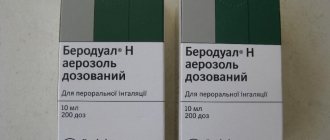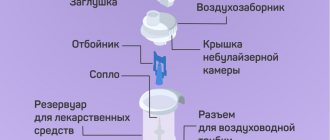Groups of inhalation drugs:
- Antiseptics (Furacilin, Dioxidin, Miramistin)
- Antibiotics (Gentamicin, Tobramycin)
- Anesthetics (Lidocaine)
- Hormonal drugs (Cromohexal, Budesonite, Pulmicort, Dexamethasone)
- Immunomodulators (Interferon, Derinat)
- Mucolytics (Fluimucil, Lazolvan, Ambroxol, Ambrohexal, Pulmozyme, Acetylcysteine)
- Bronchodilators (Berodual, Fenoterol, Ventolin, Berotek, Salamol)
- Herbal medicine (Rotokan, Tussamag, Chlorophyllipt)
- Vasoconstrictors (Adrenaline, Naphthyzin)
- Alkaline and saline solutions (0.9% saline)
Novatron, 10 pcs., 2.5 ml, 1 mg/ml, solution for inhalation
Bronchodilators should not be the only or main component of the treatment of unstable or severe bronchial asthma.
Patients using the drug Novatron at home should be warned that if the effect of the usual dose becomes less effective or shorter lasting, they should not independently increase the dose or frequency of use of the drug, but should immediately consult a doctor.
When using the drug, avoid contact of the solution with the eyes.
As with other inhalation therapies, cases of paradoxical bronchospasm may occur. In this case, you must immediately stop taking the drug and prescribe an alternative treatment. Solutions that do not correspond to a neutral pH level may cause paradoxical bronchospasm in some patients.
Salbutamol may cause reversible metabolic changes, such as an increase in blood glucose concentrations. In patients with diabetes mellitus, decompensation may develop; in some cases, the development of ketoacidosis has been reported. Concomitant use of glucocorticosteroids may enhance this effect.
Rare cases of lactic acidosis have been reported associated with the use of high doses of short-acting beta2-agonists via nebulizer, mainly in patients with exacerbation of bronchial asthma. An increase in lactate concentration can lead to shortness of breath and compensatory hyperventilation, which may be misinterpreted as signs of unsuccessful treatment of bronchial asthma and lead to an unjustified increase in the use of short-acting beta2-agonists. Therefore, it is recommended to monitor the concentration of lactate in the blood serum, as well as monitor the possible subsequent development of metabolic acidosis.
Salbutamol should be prescribed with caution to patients with thyrotoxicosis.
Treatment with beta2-agonists can lead to significant hypokalemia.
Particular caution should be exercised in cases of severe bronchial asthma, since the occurrence of hypokalemia can be promoted by concomitant treatment with xanthine derivatives, glucocorticosteroids, diuretics, as well as hypoxia. In such situations, it is recommended to monitor serum potassium levels.
Not recommended for use with nebulizers:
- All solutions containing oils
- Suspensions and solutions containing suspended particles, including decoctions and infusions of herbs
- Solutions of aminophylline, papaverine, platyphylline, diphenhydramine and similar products
- Preparations containing alcohol solutions
- Recommendations for inhalations for children:
- Do not force the child to breathe frequently during inhalations
- Do not inhale immediately after meals
- Do not spontaneously prescribe or increase drug doses prescribed by a doctor.
- Allow your child to rest after inhalation
Acute bronchitis advice from a pulmonologist
One of the common causes of cough in childhood is bronchitis. This is an inflammatory process of the mucous membrane of the bronchial tree, accompanied by swelling. Despite the apparent simplicity and supposed clarity of the understanding of this disease, parents still do not know much and make serious mistakes. Today we’ll talk to a pulmonologist about bronchitis from the perspective of evidence-based medicine.
Causes and mechanisms
The term “Bronchitis” only emphasizes the localization of the pathological process (bronchi), but does not say anything about the nature of the inflammation. It is often caused by viruses and much less often by bacteria. Moreover, it is impossible to determine the etiology just by the color and nature of the sputum.
Bronchitis is characterized by an increase in the volume of secretions produced by the bronchi. This is where the cough comes from. This is a reflex mechanism aimed at removing sputum, dust particles, viruses and other foreign substances from the bronchi.
Symptoms of bronchitis
Typical symptoms of bronchitis are cough with phlegm. The latter can have a different character - transparent, yellow or green.
With bronchitis there may also be additional manifestations:
- temperature increase;
- general weakness;
- discomfort behind the sternum.
Usually the symptoms are most pronounced in the first 3-4 days, then gradually subside. With a smooth course, recovery occurs by about 7-10 days. By the way, residual cough can last up to 3-4 weeks and in most cases it does not require therapy.
Treatment
A big misconception is the prescription of antibiotics for bronchitis. These drugs are indicated only in one case, when it is proven that bacteria are the cause of the inflammation.
The basic principles of treating bronchitis are the following:
1. Air humidification. It should also be cool. Ventilate the room - this makes breathing easier and improves coughing.
2. Drink plenty of fluids at room temperature or slightly cool. This improves sputum discharge.
3. Reducing high (!) temperature. For this, ibuprofen or paracetamol can be used in accordance with age-specific dosages. Ibuprofen and paracetamol are calculated based on the child’s weight. There is no single figure for when to lower the temperature. We focus not on the number on the thermometer, but on the child’s well-being. But it is worth remembering that a passion for non-steroids can erase the true clinical picture and prevent timely diagnosis of pneumonia.
4. Performing breathing exercises and vibration massage of the chest. These exercises improve bronchial drainage and help remove mucus from them. For the same purpose, children with bronchitis are allowed and even recommended to run, jump, play and have fun.
Pitfalls in treatment
It is worth mentioning mucolytics - drugs that thin out sputum. These medications are contraindicated for bronchitis in children under 3 years of age. The fact is that until this age, children's bronchi are narrow, and the mucous membrane contains a large number of goblet cells that produce mucus. And with all this, the cough reflex is minimally developed up to 3 years of age. Therefore, using mucolytics for bronchitis before the age of 3, we can aggravate the situation - the amount of liquid sputum increases, but it cannot be fully removed from the bronchi.
Expectorants of plant origin also require separate lighting. This group of drugs does not have reliable evidence of effectiveness. In addition, there is a risk of developing an allergic reaction to any of the components of the herbal mixture.
And some information about the use of a nebulizer, it is only needed for obstruction. And in this case, only bronchodilators are needed; there is no need to breathe mineral water, saline solution or antibiotics.
Conclusion
A clear understanding of the mechanisms and causes of the development of bronchitis helps to quickly get rid of this disease. It is important that not everything can be treated only with medications. The main place in stopping inflammation in the bronchi is given to general measures, the organization of which falls on the shoulders of the parents. Evidence-based medicine to protect your child's health!
IRS®19 for bronchitis
IRS®19
– a local immunomodulatory drug, which is available in the form of a nasal spray.
It contains a mixture of 18 lysates of bacteria that most commonly cause upper and lower respiratory tract infections. The use of a spray for bronchitis allows you to activate and restore the immunity of the nasal mucosa, which is the entry point for infection. IRS®19 begins to act immediately upon contact with the nasal mucosa and helps fight various causes of the disease (viruses and bacteria). The use of IRS®19
in combination with basic therapy helps reduce the risk of complications and relapses of infection5. Used for the treatment and prevention of a wide range of respiratory tract diseases in adults and children from three months4.
How to treat acute bronchitis
When the first signs of the disease appear (if no more than 48 hours have passed since its onset), antiviral drugs may be prescribed. Treatment of acute bronchitis with antibiotics is usually not practiced. It can be justified only if whooping cough is suspected and bacterial complications are confirmed. How to treat acute bronchitis in the presence of an intense cough? In this situation, to reduce the risk of side effects, the mechanism of action of the drug and the presence of contraindications should be taken into account. For a dry hacking cough, antitussives can be used. When coughing is accompanied by the discharge of viscous sputum, mucolytics are prescribed to improve the discharge of mucus from the respiratory tract. You can rely on herbal preparations, such as cough medicines Doctor MOM®.
There are also general recommendations that are relevant for the treatment of acute bronchitis of any nature:
- compliance with bed or semi-bed rest (depending on the patient’s condition);
- consumption of large amounts of warm fortified liquid (up to 2–2.5 liters per day). However, you should avoid drinks containing caffeine and alcohol, as they dehydrate the body and worsen inflammation. Decoctions of rose hips, raspberries and linden blossoms, fruit drinks and heated mineral water will bring benefits;
- to give up smoking;
- protecting the patient from irritating factors: dust, smoke, strong odors and toxic fumes;
- regular ventilation of the room and maintaining an optimal level of humidity in it (50-70%). To humidify the air, you can use both special climate control devices and improvised means, for example, a wet towel hung on a radiator.
In acute bronchitis, mucolytic agents are used to treat cough and facilitate mucus discharge, which thin the mucus and facilitate its removal. For example, you can use Doctor MOM® herbal cough syrup, which contains extracts of 10 medicinal herbs and has a complex effect: secretolytic (increases the secretion of protective mucus), mucolytic (reduces the viscosity of sputum), expectorant (removes phlegm), bronchodilator (relaxes the bronchi) and anti-inflammatory . The syrup is suitable for adults and children over 3 years of age. Ignoring the symptoms and inadequate treatment of acute bronchitis in adults can lead to the disease becoming chronic and the development of very serious complications.
Forms of bronchitis
There are acute and chronic forms of bronchitis. An episode of acute bronchitis does not always turn into chronic, but the chronic form is always preceded by acute inflammation. The transition of the process to chronic is facilitated by untimely initiation of treatment, the presence of bad habits, especially smoking, and environmental factors. To prevent the disease from becoming chronic, it is necessary not only to select the correct treatment for the infectious agent, but also to activate the local immunity of the upper respiratory tract. One of these drugs is IRS®19, a local immunomodulator that is used for the treatment and prevention of viral and bacterial diseases of the respiratory system4. It promotes faster recovery, prevents the disease from becoming chronic and reduces the number of relapses5.
Symptoms of obstructive bronchitis
The main and main symptom of any bronchitis is a cough.
There can be a cough without bronchitis - but there is no bronchitis without a cough!
In acute and chronic obstructive disease, sputum is coughed up during coughing. The cough is called wet or wet. Often a cough occurs without sputum - a “dry cough”.
The color of sputum when coughing is varied, from transparent to green-brown and sometimes with blood. Its color is given by bacteria that enter the bronchi during breathing and multiply.
For an acute process, light-colored sputum or yellow is more typical. For a chronic process, yellow-green, green and brown colors are more typical. This is due to chronic long-term inflammation and the presence of more aggressive microflora in the sputum.
Chronic asthmatic bronchitis is characterized by coughing attacks, sometimes with foamy or glassy sputum. A cough wakes the patient at night or in the morning. This cough interferes with exercise and when traveling on the subway. Against the background of a cough with asthmatic bronchitis, whistling sounds in the chest can be heard. The patient says “cat concert” in my chest!
A rise in temperature with these diseases is also not uncommon. This is due to the reasons that caused the development of the disease - these are respiratory viruses. An increase in temperature up to 39C, and with the flu, more than 39C are possible.
With exacerbation of obstructive bronchitis, the temperature rises slowly. At first it is small (low-grade fever), then it can unexpectedly increase and persist for a long time. Just during the period of recovery, the sputum changes from light to green or brown.
Shortness of breath, difficulty breathing
These symptoms are typical for any acute and chronic bronchitis complicated by obstruction, as well as for asthmatic bronchitis. These symptoms, plus wheezing and whistling, are associated with narrowing of the bronchi. The more pronounced the narrowing, the greater the cough, whistling and wheezing. When an infection enters the bronchial mucosa, it becomes inflamed and swollen, and its lumen decreases. The obstruction is aggravated by phlegm, which additionally blocks the movement of air during breathing and its speed sharply decreases. In this case, a person is forced to breathe more often to provide himself with oxygen. During these events, the sick person feels congestion and pain in the chest, burning, and wheezing.
In asthmatic bronchitis, obstruction occurs suddenly. This attack of suffocation causes panic in the sick person. The man says, “I had a choking attack!” Coughing up sputum during this attack is difficult, whistling and wheezing are heard in the chest.
Causes
The main role in the development of the inflammatory process in the bronchi is played by viruses or bacteria. Among the viral pathogens of this respiratory infection, the predominant ones are:
- Adenoviruses;
- Coxsackie virus;
- Parainfluenza viruses;
- Influenza viruses;
- Coronaviruses;
- Respiratory syncytial virus;
- Rhinoviruses and others3.
Bacterial infection is detected in less than 10% of cases1, which must be taken into account when choosing treatment tactics. There are a number of factors that contribute to the occurrence of bronchitis in adults:
- Smoking;
- Work in hazardous industries;
- The presence of frequent recurrent diseases of the upper respiratory tract;
- Deficiency of vitamins and microelements;
- Congenital or acquired diseases of the immune system1.
Outbreaks of incidence occur during the cold season - late autumn, winter and early spring. Often a common cold turns into bronchitis if the local immune system cannot cope with the infection.



